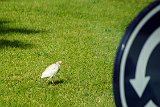
Arrival in Morocco
After an overnight flight from Dulles to Paris followed by a quick hop to Casablanca we cooled our heels in line to clear customs for 90 minutes. Fortunately our tour guide waited. We drove for another 90 minutes to our hotel in Rabat. That evening we had a very nice welcome dinner at the Golden Fish restaurant in the hotel. Of the 11 people on the tour, 7 were from northern Virginia. The next morning we toured Rabat. It turned out that there was a marathon going on and many of the roads were closed. I took this picture of a cattle egret foraging in a traffic circle while waiting for the roads to open.
Image 1 of 30
Arrival in Morocco
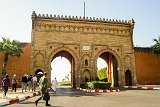
Avenue Bab Soufara Gate
The first stop of our tour was this gate at the north end of Avenue Bab Soufara. The gate leads the Commune of Touarga, an enclave in the town of Rabat. It contains the official residence of the King of Morocco is (Dar al-Makhzen royal palace), the Ahl Fas mosque, Méchouar Park, the Prime Minister's Department and the Ministry of Endowments and Islamic Affairs. This gate, known as the "Door of Ambassadors, is one of 5 gates into Touarga. On June 23, 1786 Morocco became one of the first nations to formally recognize the United States. In 1821 their sultan provided a home for the American Consul General. This is now the oldest American diplomatic property in the world.
Image 2 of 30
Avenue Bab Soufara Gate

Dar al-Makhzen, The Royal Palace in Rabat
At the end of Avenue Bab Soufara is Dar al-Makhzen, The Royal Palace in Rabat. This collage shows the entrance gate to the palace (upper picture). Our guide told us that the current king does not live there. He chooses to live north of the city and commute to his office in Dar al-Makhzen. The lower two pictures show close-ups of the Moroccan Royal Guard guards on either side of the gate. They are dressed in the three uniforms they wear with the red uniforms being their ceremonial dress uniform. These pictures were taken from as close as the tourist public is allowed.
Image 3 of 30
Dar al-Makhzen, The Royal Palace in Rabat

Ahl Fas Mosque & Administration of National Defense Collage
These are two of the buildings within the Touarge. The top picture is the Ahl Fas Mosque which dates from the 18th century. The bottom picture is of the Administration of National Defense - Morocco's Pentagon.
Image 4 of 30
Ahl Fas Mosque & Administration of National Defense Collage
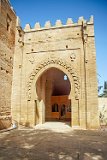
Chellah Necropolis
Our next stop was Chellah, the site of Phoenician, Roman and Muslim Arab colonies / settlements dating back thousands of years. Originally known as Sala, after the Berbers overthrew the then fortress they used the site as a royal burial ground or "chellah" in the 13th century. This picture shows its entry gate.
Image 5 of 30
Chellah Necropolis

Roman Ruins
This panorama shows some of the Roman era ruins of their colony Sala in Chellah. Sala was a sigThis panorama shows some of the Roman era ruins of their colony Sala in Chellah. Sala was a significant port city. The remains of a Roman road leading down to the port can be seen in the lower left and rightnificant port city. The remains of a Roman road leading down port can be seen in the lower left and right
Image 6 of 30
Roman Ruins
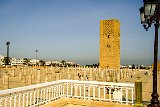
Hassan Tower and Unfinished Mosque
The next stop on our tour was the Yacoub al-Mansour esplanade. It is the site of of an unfinished mosque and minaret commissioned in 1195 by then Caliph Abu Yusuf Yaqub al-Mansur. The tower and mosque were intended to be the largest in the world. When al-Mansur died in 1199 construction stopped. The tower was planned to be 260 feet high. It was designed to be large enough for an imam could ride a horse to the top to issue the call to prayer. The unfinished tower is 140 feet high.
Image 9 of 30
Hassan Tower and Unfinished Mosque
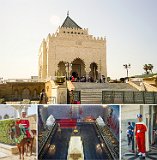
Mausoleum of Mohammed V Collage
On the opposite end of the esplanade from the Hassan Tower is the Mausoleum of Mohammed V. According to Wikipedia " The building is considered a masterpiece of modern Alaouite dynasty architecture"( See the top picture in the collage). It was completed in 1971 and contains the bodies of King Mohammed V and his two sons King Hassan II and Prince Abdallah (see the center bottom picture in the collage). The Mausoleum is guarded by the Moroccan Royal Guard in their red ceremonial dress uniforms. They had no objections to being photographed, however when I heard some horses walking in the back below the Mausoleum, I was sternly warned not to take any pictures.
Image 10 of 30
Mausoleum of Mohammed V Collage
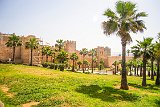
Kasbah of the Udayas
At the mouth of the Bou Regreg river is the is the Kasbah of the Udayas. A kasbah consists multiple buildings of a citadel behind a defensive wall. It was built in the 12th century on the ruins of a smaller kasbah and reinforced to become a major fortress for launching attacks on Iberia. The Arabic term "ribat" means a fortification or stronghold. The fortress acquired the title 'Ribatu l-Fath", meaning "stronghold of victory," The city of Rabat derives its current name from this title. This picture shows the land side of the kasbah.
Image 11 of 30
Kasbah of the Udayas
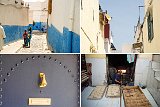
Kasbah of the Udayas Collage
As seen in the upper left picture, the outside building walls of the kasbah are painted the traditional blue and white. However as traditional as their buildings are, the upper right picture shows the first of a multitude of satellite dishes we saw during our visits to kasbahs and medinas throughout Morocco. The lower left picture shows the "Hand of Fátima " an ancient talisman symbolizing feminine power found in many religions. In Islam Fátima is daughter of the prophet Muhammad. The hand is a defense against negative energy, deflecting the gaze of the evil eye away from the home. It is also believed to channel the forces of good, it is said to promotes healing and fosters miracles. The bottom right picture shows a communal bakery. Residents deliver freshly kneaded dough and the bakers then bake "Khobz" the traditional Moroccan bread.
Image 12 of 30
Kasbah of the Udayas Collage
Kasbah of the Udayas From The River Side
This panorama shows the kasbah from the river side. It was taken from across the river in Salé
Image 13 of 30
Kasbah of the Udayas From The River Side
Modern Salé
This is a panorama of the modern city of Salé which is across the Bou Regreg river from Rabat.
Image 14 of 30
Modern Salé
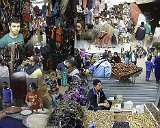
Rabat Medina Collage
After the scheduled touring for the day, our guide took those of us who wanted to come to the Rabat Medina. In this album "medina" refers to a distinct city section, typically walled, with many narrow and maze-like streets. It is frequently a marketplace. This collage shows typical views of the Rabat medina. I know it is very busy, which is appropriate because it reflects the atmosphere in the medina.
Image 15 of 30
Rabat Medina Collage
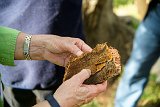
Cork Tree Bark
On our second day of touring we drove from Rabat to Fez by way of the Roman ruins at Volubilis and the city of Meknes. Shortly after we left Rabat we pulled over in a forest of cork oak trees. In this picture our guide shows us a piece of bark from one of the trees. The tree has a thick insulating bark which makes it resistant to forest fires. Careful harvesting of the bark does not harm the tree, and the bark regrows. The first harvest occurs at age 25, and after that it can be harvested every 9-12 years. They typically live for 200 years
Image 16 of 30
Cork Tree Bark

Moulay Idriss Zerhoun Panorama
En-route to Volubilis we stopped at a viewpoint to see this city perched on a hill. This town was founded by Moulay Idriss in 789 He brought the religion of Islam to Morocco. He also initiated construction in Fez, continued later by his son, Moulay Idriss II. Since the ruins of the Roman city of Volubilis are located just five kilometers away, many materials were taken from there in order to build this town.
Image 17 of 30
Moulay Idriss Zerhoun Panorama

Volubilis Panorama
The Volubilis ruins are of an ancient Berber and Roman city dating to the 3rd century B.C The Romans took over rule of the city in the 1st century A.D. After the fall of Rome the city remained inhabited by various peoples and religions until the 11th century after which most of the population relocated to Moulay Idriss Zerhoun. The ruins remained basically intact until the 1855 Lisbon Earthquake. Subsequently they were looted for building materials used in Meknes. This panorama was taken from the visitors center.
Image 18 of 30
Volubilis Panorama

Volubilis Collage
This collage shows various sites in Volubillis, Including the northern public baths (top left), an entrance arch to the city (upper right), the Capitoline Temple (center right), the Arch of Caracalla (lower right), the basilica (lower left), a mosaic tile floor (center left) and a sun dial (very center).
Image 19 of 30
Volubilis Collage
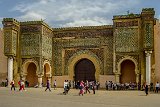
Bab Mansour (Meknes)
This gate, which translates as "Gate Victorious", was commissioned by Sultan Moulay Ismail. Rather than a fortification, it was designed to be a symbol of the sultan's power. It was designed and built by a convert named Mansour Laalej. According to local legend, when the gate was completed Moulay inspected it and asked Mansour if he could do better. Mansour felt compelled to answer “yes”, which angered the sultan to the point that he had him executed! In fact records show it was completed in 1732, after the sultan’s death. Note, the two marble columns on either side of the gate were taken from the Volubilis. I stood across the main road from the gate for a while, taking picture after picture hoping to be able to photo merge several of them into one picture without cars. Afterwards when I reviewed the pictures I discovered that this one could be cropped to eliminate the single car on the far left.
Image 20 of 30
Bab Mansour (Meknes)

Fes el Bali (old Fez) Panorama
This panorama of the old city of Fez el Bali, aka the Fez Medina was taken from an overlook on Morocco National Route 6. Founded in the late 8th century. With its narrow streets and alleyways, it is believed to be the biggest car-free urban area in the world. It is the site of University of Al Quaraouiyine. Founded in 859 A.D. it is the oldest, continually operating, degree granting university in the world.
Image 21 of 30
Fes el Bali (old Fez) Panorama

Riad Salam Fes Collage
In Fez we stayed two nights at the Riad Salam Fes. (A Riad is a traditional Moroccan building with an interior garden or courtyard.). Our room was on the top floor. Since there was minimal air conditioning, we left the windows open at night and would be awakened in the morning by the Fajr (dawn) call to prayer. It occurs at the beginning of twilight and ends at sunrise This collage shows a common characteristic of buildings in the medinasWe stayed two nights in Fez at the Riad Salam Fes. (A Riad is a traditional Moroccan building with an interior garden or courtyard.). Our room was on the top floor. Since there was minimal air conditioning, we left the windows open at night and would be awakened in the morning by the Fajr (dawn) call to prayer. It occurs at the beginning of twilight and ends at sunrise, When we checked out they had presents for all of us - scarves for the ladies and fez (hats) for the gentlemen. The ladies liked their scarves, we guys sort of lost our fezzes on the bus :-) This collage shows a common characteristic of buildings in the medinas and other old areas - while the exteriors are very non-descript, the interiors are gorgeous. The upper picture in this collage shows the exterior whereas the lower picture shows the interior. and other old areas - while the exteriors are very non-descript, the interiors are gorgeous. The upper picture in this collage shows the exterior whereas the lower picture shows the interior.
Image 22 of 30
Riad Salam Fes Collage
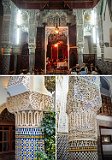
Fez Interior Designs Collage
This collage shows some of the interior designs we saw. The upper picture is the interior of a restaurant we had lunch in. The lower two are random interior columns. In all the columns I noticed, the carved plaster was always above the tile.
Image 23 of 30
Fez Interior Designs Collage
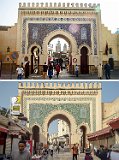
Bab Bou Jeloud Collage
Bab Bou Jeloud is the monumental blue/green gate on the west side of the Fez Medina. After the advent of gunpowder and heavy artillery, fortified gates were no longer particularly useful for defense and they took on decorative role. The blue (color of the city) side of the gate faces the outside (top picture) whereas the green (color of Islam) side of the gate faces the inside (lower picture). Since this gate was not built until 1913 when Morocco was a French Protectorate, it was actually designed and built under French auspices. They built the doors of the gate to close and lock from the outside!! The central minaret visible through gate is that of the Bou Inania Madrasa,
Image 24 of 30
Bab Bou Jeloud Collage

Bou Inania Madrasa Collage
The Bou Inania Madrasa was built in the 14th century. and restored in the 20th century. Originally it was both a mosque and a school. It is still an active mosque yet non-Muslims may enter it. It is the minaret of this building that can be seen through the Bab Bou Jeloud gate. The top picture shows the central courtyard with its green roof tiles, brown carved cedar above elaborate plaster work above ceramic tile. The lower picture shows something I did not associate with mosques - stained glass windows.
Image 25 of 30
Bou Inania Madrasa Collage

Chouara Tannery
The Leather tanneries in Fez have been continuously operating on the same site since the 11th century. The tanners still follow the ancient methods for treating leather. Hides are soaked for a few days in white vats full of cow urine, quicklime, water and salt. They are then picket out and dried. The next step is to be placed a different set of vats (also white) filled with diluted pigeon excrement and water for softening. Using their bare feet and hands, tanners knead the skins to the desired softness. Finally they move on to the dying process (brown vessels). The dyes used in the tannery pits are natural: Blue comes from indigo; red, from poppy or paprika; yellow, from saffron, pomegranate, or even a mix of turmeric and mimosa flowers. This picture was taken from the upper viewing terrace of a leather retail shop on the edge of the tannery.
Image 26 of 30
Chouara Tannery
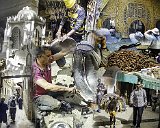
Fez Medina Collage
This collage is made from several pictures I took as we toured the Fez Medina. Among the more interesting shots are the top center of an older gentleman sharpening a knife. He was pedaling the grindstone!; the very center a gentleman was silver soldering the interior of a copper pot over a gas burner. He jokingly offered to buy one of the young ladies in our group as a bride for his son; and in the lower right a burro loaded with tiles taking them somewhere. . I know this collage is very busy, which is appropriate because it reflects the atmosphere in the medina.
Image 27 of 30
Fez Medina Collage

Dar al-Makhzen - The Fez Royal Palace
Dar al-Makhzen is the royal palace of the King in Fez. It is located in the Fes Jdid section. While its name means "New Fez", it was founded in 1276 and is new only in relation to Fes el Bali (old Fez- found in the 8th century). The palace is known for its ornate brass doors surrounded by intricate ceramic work, topped by carved cedar wood and green tile roofs. It is not open to the public. I took this picture during a break between tour group arrivals.
Image 28 of 30
Dar al-Makhzen - The Fez Royal Palace
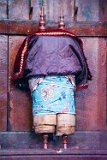
Ibn Danan Synagogue
Our last stop on the Fez tour was the Ibn Danan Synagogue. Also located in the Fes Jdid section, it dates from the 17th century and was restored in 1999. This is one of its original torah scrolls, made of gazelle skin.
Image 29 of 30
Ibn Danan Synagogue
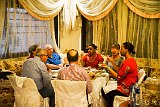
Dinner With A Local Family
That evening we were invited to dinner with a clearly well off local Fez family. It consisted of a grandmother, husband & wife, an early teenage daughter and a son about 7. Unfortunately my high school French was not up to the task of conversation and their English was practically non-existent. It was an enjoyable meal. This is a picture of the dining area.
Image 30 of 30
Dinner With A Local Family



